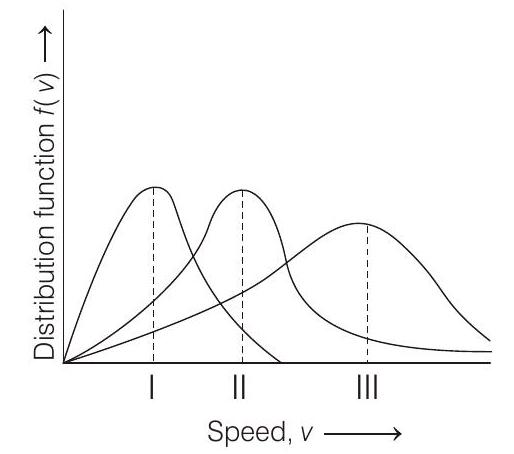States of Matter 1 Question 1
1. Points I, II and III in the following plot respectively correspond to ( $v_{\mathrm{mp}}:$ most probable velocity)
(2019 Main, 10 April II)

(a) $v_{\mathrm{mp}}$ of $\mathrm{H}{2}(300 \mathrm{~K})$; $v{\mathrm{mp}}$ of $\mathrm{N}{2}(300 \mathrm{~K})$; $v{\mathrm{mp}}$ of $\mathrm{O}_{2}(400 \mathrm{~K})$
(b) $v_{\mathrm{mp}}$ of $\mathrm{O}{2}(400 \mathrm{~K}) ; v{\mathrm{mp}}$ of $\mathrm{N}{2}(300 \mathrm{~K}) ; v{\mathrm{mp}}$ of $\mathrm{H}_{2}(300 \mathrm{~K})$
(c) $v_{\mathrm{mp}}$ of $\mathrm{N}{2}(300 \mathrm{~K})$; $v{\mathrm{mp}}$ of $\mathrm{O}{2}(400 \mathrm{~K})$; $v{\mathrm{mp}}$ of $\mathrm{H}_{2}(300 \mathrm{~K})$
(d) $v_{\mathrm{mp}}$ of $\mathrm{N}{2}(300 \mathrm{~K}) ; v{\mathrm{mp}}$ of $\mathrm{H}{2}(300 \mathrm{~K}) ; v{\mathrm{mp}}$ of $\mathrm{O}_{2}(400 \mathrm{~K})$
Show Answer
Solution:
Key Idea From kinetic gas equation,
Most probable velocity $\left(v_{\mathrm{mp}}\right)=\sqrt{\frac{2 R T}{M}}$
where, $R=$ gas constant, $T=$ temperature, $M=$ molecular mass
| $v_{\mathrm{mp}}=\sqrt{\frac{2 R T}{M}}$, i.e. $v_{\mathrm{mp}} \propto \sqrt{\frac{T}{M}}$ | |||
|---|---|---|---|
| Gas | $\boldsymbol{M}$ | $\boldsymbol{T}(\mathrm{K})$ | $\sqrt{\boldsymbol{T} / \boldsymbol{M}}$ |
| $\mathrm{H}_{2}$ | 2 | 300 | $\sqrt{300 / 2}=\sqrt{150} \ldots$ III (Highest) |
| $\mathrm{N}_{2}$ | 28 | 300 | $\sqrt{300 / 28}=\sqrt{10.71} \ldots$ I (Lowest) |
| $\mathrm{O}_{2}$ | 32 | 400 | $\sqrt{400 / 32}=\sqrt{12.5} \ldots$ II |
So,
I. corresponds to $v_{\mathrm{mp}}$ of $\mathrm{N}_{2}(300 \mathrm{~K})$
II. corresponds to $v_{\mathrm{mp}}$ of $\mathrm{O}_{2}(400 \mathrm{~K})$
III. corresponds to $v_{\mathrm{mp}}$ of $\mathrm{H}_{2}(300 \mathrm{~K})$










